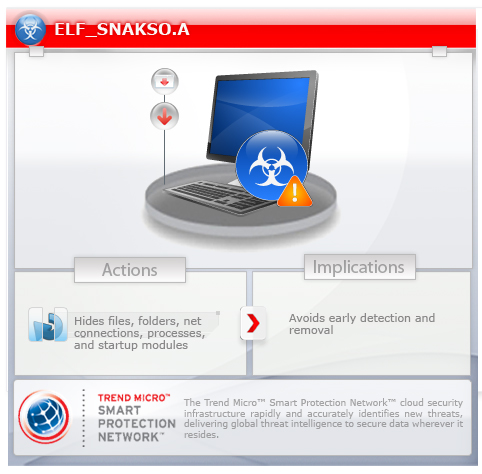ELF_SNAKSO.A
Linux/UNIX


Threat Type: Backdoor
Destructiveness: No
Encrypted: No
In the wild: Yes
OVERVIEW
This malware targets Linux OS and has the capability to hide files, processes, and folders among others.
To get a one-glance comprehensive view of the behavior of this Backdoor, refer to the Threat Diagram shown below.

This backdoor arrives on a system as a file dropped by other malware or as a file downloaded unknowingly by users when visiting malicious sites.
TECHNICAL DETAILS
Arrival Details
This backdoor arrives on a system as a file dropped by other malware or as a file downloaded unknowingly by users when visiting malicious sites.
NOTES:
It adds an entry to /etc/rc.local to ensure its automatic execution in every system startup.
It retrieve kernel symbols and write them to the following file:
- /.kallsyms_tmp
It then deletes the said file afterwards.
It hooks the following functions to hide files:
- filldir
- filldir64
- vfs_read
- vfs_readdir
It attempts to hide the following files to hide its presence on the affected system:
- zzzzzz_command_http_inject_for_module_init
- zzzzzz_write_command_in_file
- module_init.ko
- sysctl.conf
- /usr/local/hide/first_hide_file
- /ah34df94987sdfgDR6JH51J9a9rh191jq97811
It also hides the following threads to make its execution not visible:
- backconnect_command_thread_name
- new_backconnect_command_thread_name
- read_command_http_inject_thread_name
- write_startup_command_thread_name
- write_se_linux_command_thread_name
- get_http_inj_from_server_thread_name
It is capable of hiding the following:
- Files and folders
- Net connections/packets
- Processes
- Startup modules
It modifies the function tcp_sendmsg with its new function to inject iFrames into the outgoing TCP packets.
SOLUTION
Scan your computer with your Trend Micro product to delete files detected as ELF_SNAKSO.A . If the detected files have already been cleaned, deleted, or quarantined by your Trend Micro product, no further step is required. You may opt to simply delete the quarantined files. Please check this Knowledge Base page for more information.
Did this description help? Tell us how we did.

